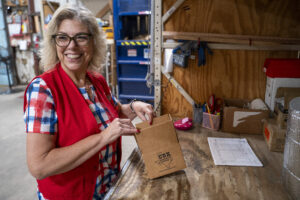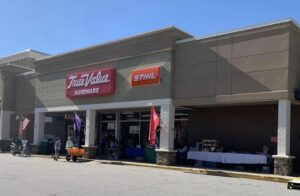The question is not will e-commerce and web-based businesses supplant brick-and-mortar retailing… but will it simply leave you behind if you don’t adopt the technology and integrate e-commerce into the core of your business.
If you were to guess when that paragraph was written, you might say it was last week. Or maybe it was the height of 2020 when retailers were scrambling to put their inventory online and set up curbside pickup.
Would you believe it if you learned it was from a column by former Hardware Retailing editor-in-chief Mark Parrott published in December 1999?
Whether you can fathom it or not, retailers large and small have been trying to capture customers’ attention online for the better part of 30 years. Independent home improvement retail hasn’t been at the forefront of online strategy or e-commerce, likely because the channel hasn’t needed to compete against online giants in the same way as say their independent bookseller counterparts. The industry has benefited from consumers’ desires to pick up a drill, match paint to their curtains or consult the decades of knowledge that often resides inside the four walls of their local hardware store.
But the dynamic has changed.
Even in the last several years, and most definitely since 1999, customer expectations around a retail experience are significantly different. And the North American Hardware and Paint Association (NHPA) wanted to find out how retailers have been responding to those changes. In a recent survey to about 200 retailers representing nearly 600 stores, NHPA asked respondents to share their approach to an online presence, including websites, e-commerce and digital marketing. Some respondents were gracious enough to offer additional insight into their strategies. On the following pages, learn from three of those retailers about their distinct approaches to being online.
 Cox Hardware & Lumber
Cox Hardware & Lumber
- Been online since 1999
- E-commerce is 2.5% of overall sales
- coxhardware.com
For nearly 80 years, Cox Hardware & Lumber has been serving downtown Houston across three distinct segments. What started as a small business running out of a rented storefront behind Henry and Mary Cox’s family home is now a hub for commercial, industrial and residential business across southeastern Texas and beyond.
Taylor Cox is a purchaser and manager for the operation and is the fourth generation to be involved in the business. He joined in 2016 after serving in the U.S. Army.
The store carries about 31,000 SKUs, including traditional hardlines categories, with about 8,000 SKUs in fasteners alone, in addition to a large selection of abrasives, cleaning supplies and paint and industrial coatings. The lumber department is housed in a 7,000-square-foot pole barn, along with an acre of outdoor storage.
“We’re inside the loop here in Houston, which is the industrial belt,” Taylor says. “We kind of act like an industrial distributor.”
Virgil Cox has been involved in the business since he was in junior high in the early 1970s, and he started the company’s initial foray into a web presence. In the 1980s, Virgil compiled product information, including images, SKUs and manufacturer details, into comprehensive catalogs spanning nearly the store’s entire inventory, printing and mailing 5,000 copies. In 1999, he led the process of converting the catalogs into the company’s first website in order to drive online traffic into the store. Taylor says driving in-store traffic is still the basis of their online strategy today, although the website has undergone numerous updates since that first iteration, including several major e-commerce enhancements.
About 2.5% of the company’s overall sales are online transactions, but Taylor estimates that percentage would be higher if it incorporated implicit sales.
“Someone will walk in with our website pulled up on their phone and buy a product they found online in store,” he says. “And a lot of customer phone calls are about something they see on the website.”
The current version of the website was initially developed about 10 years ago, and Taylor says it was built to extend the store to their customers’ desktops. The landing page allows shoppers to choose items from a list of departments, brand names or search for a specific item or part number. It also shows the featured items, including sale items and new products. Each individual item listing includes the SKU, brand name, item weight and quantity available. At the bottom of the page, there are recommended items that are related to the product, whether they are frequently purchased together or are items that are needed to use the selected product. Taylor says about 60% of the product information comes from their wholesalers, but the remaining information they source from the vendors they buy from directly.
Taylor says about 60% of orders are buy online, pickup in store and the remainder are shipped from the store’s inventory throughout the contiguous U.S.
Website manager Joann Rodriguez has been with the company for 28 years and was present for the website’s inception. Today, she oversees the website’s operation and day-to-day tasks such as SKU deletions, product data enrichment. For other more complex maintenance and issue resolution, they rely on their developer who is based in Boston. Shipped orders are managed by another team member.
“The team we have managing website updates and orders is integral to the success of the site,” Taylor says.
The store primarily uses UPS for shipping and customers pay for shipping. Taylor says they don’t offer free shipping, but some items are eligible for a quantity discount, which they also offer to in-store customers. For some people, the shipping is worth it if it means they can access hard-to-find items. They recently had a customer order one sheet of crocus cloth for $1.20 and pay full price for shipping because he wasn’t able to locate the product anywhere else.
About two-thirds of the orders placed online come from commercial/industrial customers. Customers with store accounts are able to pay with a purchase order online and have the option to log into the website and see their order history, which is a big draw for Cox’s large professional customer base.
A major challenge for online retail is to maintain repeat business, Virgil says.
“It’s easy to get someone to visit once, but in order to get them to return again and again, you have to offer something that the customer wants, or even needs, that is unavailable elsewhere,” he says.
For every product on the Cox Hardware website, inventory detail like quantity on hand, quantity on order, price and available discounts are served to the website every few minutes all day long from the in-store server. The information is date and time-stamped, which Virgil says is to communicate relevance to potential customers. The goal is for that dynamic product data, combined with relevant product descriptions and images, to give enough information for customers to be able to make a purchase decision.
A critical piece of a successful e-commerce strategy is accurate inventory, and the Cox Hardware & Lumber team takes that seriously. Each department head counts a certain amount of their department every day using an RF gun.
Progress is tracked in the office and updated on a fixture map of the salesfloor, showing the store manager the count status of the whole store. Additionally, management staff check the previous day’s counts and double-check variances for accuracy. Those variances are communicated back to staff and are a key performance indicator of reviews.
That data is what sets Cox Hardware & Lumber apart from other operations, either in-store or online, Virgil says.
“People go to the web for information,” he says. “Our commitment, dating back to our catalog days, has always been to provide our customers with all the information they need to be sure they’re getting the right product. The website makes it easy for them to find that information quickly. Our process ensures that the data we present is accurate and trustworthy. This lets us extend our store to our customers’ computers or phones.”
While Taylor and Virgil are happy with the system they have in place, at a decade old, they understand that this version of the website could use an update. The next phase is modernization, mobile optimization and assessing the content.
“We have parts of an update prepared, but we’re still testing it out,” Taylor says. “We have a lot of data now, and we’re looking at ways to integrate that with vendor and manufacturer data.”
Taylor says retailers who haven’t gotten online should consider what it can do for their business, even without e-commerce, from a visibility perspective.
“Our website is integral to our business. We’re getting really good with lead generation. If people search for something like ‘hardware store in Houston,’ we’re near the top of the results,” he says. “If you’re not online, you need to look in the mirror.”
Family Hardware
- Built website internally
- E-commerce is 25% of overall sales
- familyhardware.com
Bringing first-time customers into your business is a challenge every retailer contends with, regardless of how long an operation has been in a community. For a business to make 25% of its overall sales from single-purchase or first-time customers seems nearly impossible. But that’s the case for Family Hardware and its e-commerce program.
Family Hardware in Cape Coral, Florida, opened in 1976 under a different name and was operated by several owners until current owner Jeremy Peterson bought the business in 2012. He built a second store in a converted strip mall in Fort Myers in 2022. Peterson has made significant investments in the business to create the reputation of “family,” specializing in offering a customized experience for every customer who walks in the door.
A customized experience is what online shoppers get as well. And it’s truly custom, as the POS, website and e-commerce platform Family Hardware uses is a completely tailor-made system that Peterson and a developer built entirely themselves.
Peterson says he does not have a formal education in IT but grew up surrounded by technology and enjoys experimenting with innovation.
“When I was redesigning and updating the company website, the backend was similar to what we needed for the POS system,” Peterson says. “So as were getting the store in Fort Myers ready to open, we were building out the website and POS system with the developer. We were able to get the new POS system ready for launch on Day 1 of the store opening.”
While going out on his own was a big risk, for Peterson, his willingness to create his own solution paid off with a successful system that he also implemented into the original location.
“We learned that just because you pay for a service, doesn’t mean it is always going to work for you,” he says. “There is a sense of pride in knowing that our system fulfills our needs.”
The system they were running e-commerce on before building the new platform didn’t meet Peterson’s expectations. The system couldn’t accommodate all of the SKUs they wanted to be able to sell, which includes over 60,000 items from their wholesaler and products sourced from other vendors.
“The previous platform didn’t manage traffic well, and if any little thing broke, it would crash,” he says. “The new system is so fast, and it performs well on mobile.”
In just two years, the new e-commerce platform now brings in about 25% of the company’s overall sales, and Peterson says most of those are small orders for niche products.
3 E-Commerce Insights
The 2024 Independent Home Improvement E-Commerce Study gives insights into the spectrum of the independent channel’s approach to being online. You’ll find data around the platforms your peers are using, where they’re getting their product information, how they manage orders from in-store pickup to delivery and the tools they find most successful for digital marketing. To see the complete report, go to YourNHPA.org/ecommerce.
- 49% of respondents have e-commerce
- E-commerce represents about 3.4% of overall sales on average
- 33% of total e-commerce sales are buy online, ship to home
Source: Home Improvement E-Commerce Study, NHPA, 2024
Generally speaking, every e-commerce sale is the result of someone with a problem searching for a solution on Google or another search engine, Peterson says. His goal with the Family Hardware e-commerce site is to be near the top of their search results and earn that sale.
Peterson connects his store’s inventory to Google Products, which means when someone searches a part number or a product name, Family Hardware’s inventory shows up in the product results at the top of the page.
“Our website traffic is purpose-driven,” he says. “People can’t find a product locally, so they search for it online, and our website comes up for them.”
Peterson says the most challenging part of driving sales online is determining what products to promote so they show up on Google Products. He spends a few hours a week putting Google Ads marketing dollars behind certain products to try to push them to the top of search results.
“You can’t single out one item that does well because as soon as you focus on something, the trend goes away,” he says. “The more you tweak the products you’re promoting, the worse it is. It’s very important to tweak and observe. In the beginning, I was very guilty about tweaking and not giving it time to work before fixing it again.”
Right now, Family Hardware only offers buy online, ship to home, and shoppers pay for shipping up to a certain dollar value. For the majority of items, they charge a $3.99 flat fee for shipping, and then depending on the margin, orders over $49 or $75 earn free shipping. The system automatically calculates the shipping fee. For expedited shipping, shoppers have the option for UPS or FedEx, which they pay for regardless of the basket size.
“People are willing to pay for shipping if they really need an item,” Peterson says.
All of the orders are shipped from one of Family Hardware’s wholesaler’s distribution centers, whichever is closest to the shopper. Peterson says this system works well for him, and it wouldn’t make sense from a labor perspective for him to bring someone in-house to manage orders and shipping from the store.
Peterson also relies on his wholesaler for product information management, or PIM, whether it’s images, product descriptions or specifications. He says when building an e-commerce website, PIM is the most important component. The second most important piece is the search function, which is closely tied to the system being able to suggest related products or products that are frequently purchased together. On the Family Hardware website, nearly every product shows variations of that item, for example, a PVC elbow that comes in a few different sizes. Each available size is shown as an option underneath the selected item.
While buy online, pickup in store is something he has considered implementing, since the majority of their online shoppers are from anywhere in the contiguous U.S., Peterson says it’s not part of the next phase. In the meantime, the item quantity is shown for every product that Family Hardware also sells in-store, so if someone is local, they know how many are available.
The next investment he wants to make is to add a loyalty program into the customer accounts so they can garner more repeat online shoppers. Right now, because the system is tailored to providing online shoppers with niche items or things they can’t find locally, there aren’t a lot of returning shoppers. By adding loyalty, Peterson expects to be able to grow that segment and encourage local shoppers to buy online using their Family Hardware loyalty account.
“By bringing rewards into it, people are gaining something tangible from shopping on our website,” he says. “With loyalty, we can send out emails and remind people that they have reward dollars to spend, and hopefully that will drive more recurring traffic.”
True Value of Rock Hill
- No website
- Annual revenue: <$2 million
The legacy of True Value of Rock Hill goes back further than the store’s four-year history.
Co-owner Jay Simpson’s father owned and operated a hardware store in nearby Chester, South Carolina, and Alex Dorsey started working at that store as a teenager. The company and the ownership team, which included Simpson’s father and another business partner, had spent decades developing a reputation for service, knowledge and overall goodwill.
After 16 years in the business and earning an ownership stake in that business, Dorsey wanted to start his own store. At the time, Simpson had recently graduated from college and wasn’t sure what his next steps would be.
“Even though my dad had owned the store while I was growing up, I had no experience in the industry,” Simpson says. “But I thought I would give it a shot. It was certainly a big learning curve, but I learned that if you take care of your customers, they’ll keep coming back.”
Simpson and Dorsey worked with their wholesaler to open up the store in Rock Hill, which is about 20 miles from Chester and about the same distance from big-box competition. Dorsey and Simpson were confident that the reputation at the Chester store would carry over into the new location.
They planned the store’s grand opening for April 2, 2020, the same day the state of South Carolina issued businesses to close due to the pandemic.
“We didn’t know what was happening,” Simpson says. “We probably stayed closed for about a month.”
Eventually, hardware stores were deemed essential and the store was able to reopen. In the meantime, Simpson had connected with a local veterinary lab that had started making hand sanitizer. True Value of Rock Hill became the only distributor of hand sanitizer in town, eventually selling over 15,000 bottles. They also started stocking face masks, including handmade ones from area residents. The store also donated PPE and sanitizer to local first responders.
“We kind of became a sanitary shop as well as selling hardware,” he says.
Since then, the business has continued to serve the community in unique ways. True Value of Rock Hill typical customers are DIYers over the age of 50 who are shopping for plumbing, electrical and lawn and garden supplies.
Homes in the area are about 50 years old in average, so maintenance or repair projects make up the majority of sales. The 8,500-square-foot salesfloor is home to core hardlines products, and there is a power aisle for outdoor power equipment. But Simpson has also forged relationships with local farmers to serve as another place for shoppers to access fresh food. The store stocks frozen meat, raw milk, lettuce and eggs. They also sell canned goods and local grilling spices. Simpson says the raw milk draws people over 30 miles away from North Carolina, which has different regulations around raw milk sales.
The primary way the store communicates to customers about sales, new products and produce availability is through the True Value of Rock Hill Facebook page. The store doesn’t have a website, and Simpson says it’s not a priority for him right now because they have such a loyal following on social media.
Currently, the store has about 1,600 followers, and each post garners a handful of reactions, comments and shares. A post celebrating Dorsey’s birthday received 95 comments.
“We use Facebook as our primary source of advertising,” Simpson says. “We try to be very personable. It’s very relaxed. We’re not just the True Value store, we’re people of the community. We’re not just trying to make a profit, we have fun too.”
Simpson says the Facebook page is managed by a friend of his who stops by the store nearly every day to take photos and find out what promotions and sales are running. The majority of the posts are photos of staff, new displays or even just a simple photo of the store’s paint department. The process may be unconventional, but it’s working for them for the time being.
Simpson also has access to the account and posts as needed. The next phase of the operation’s online presence will be focused on digital marketing. They recently signed up for their wholesaler’s digital ad program that uses geotargeting to push ads out to people in the store’s service area. Simpson says the goal is that it will boost revenue by $30,000, and it’s managed by their wholesaler, so they don’t need to invest time in it on a day-to-day basis.
“We just started it, so we haven’t seen results yet, but we wanted to try it to see what it would bring in,” he says.
Simpson says the time it takes to set up and manage a website is not something he can prioritize right now. Customers call and ask about a product, and he is happy to place the order for delivery on the next truck, which takes about three days. He says sometimes people call in thinking they are calling a different local store, but he’s happy to source an equivalent product and match the price.
To fill the e-commerce gap, Simpson says he considered selling on Amazon, but the fees they would take off the top of the sales made it cost prohibitive.
“I’m not against a website, I just don’t see a huge need for it at the moment,” he says. “We would probably have to hire someone full time to manage it, and that’s not in the cards right now.”
 Hardware Retailing The Industry's Source for Insights and Information
Hardware Retailing The Industry's Source for Insights and Information






